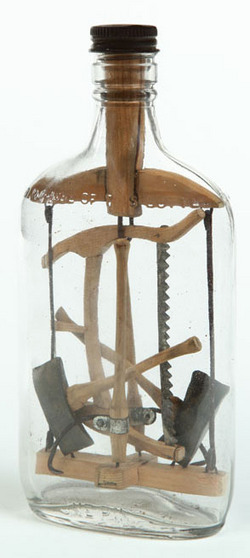 The ship in a bottle has become an icon of sorts, a necessity in any scene depicting an expensively decorated office with a nautical theme, a visual gag as a stand-in hobby for any character when one wants to convey a level of obsessiveness or fustiness. As usual, these sorts of stereotypes aren’t really accurate, in part simply because it wasn’t just ships that were assembled in bottles, but a wide range of folk art creations.
The ship in a bottle has become an icon of sorts, a necessity in any scene depicting an expensively decorated office with a nautical theme, a visual gag as a stand-in hobby for any character when one wants to convey a level of obsessiveness or fustiness. As usual, these sorts of stereotypes aren’t really accurate, in part simply because it wasn’t just ships that were assembled in bottles, but a wide range of folk art creations.
In many respects, bottle whimsies, as the form is called, share their origins and themes with the rest of the folk art world. They were typically made by people either on the fringes of society (drifters, prisoners, the mentally ill, etc.) or those who found themselves in isolated circumstances for extended periods of time (sailors, loggers, soldiers at remote posts, etc.), and the majority of them seem to be made by men and unsigned. Most of the bottles date from around the 1870s to the 1930s, but bottles from the 1850s through the 1950s are occasionally seen, but since little is generally known about the makers, it’s difficult to say if these dates also define the artwork. And, like much folk art, religion is a common theme with a number of bottles containing depictions of Christ on the cross.
Because of their more recent age, rustic nature, and mysterious origins, bottle whimsies aren’t typically as appreciated by collectors as some other folk art forms (scrimshaw, carvings, etc.), but researchers have made some connections that allow them to attribute certain bottles to the same maker, even if the maker’s identity remains unknown. Carl Worner is the most prolific known maker, and while little is known about his life, 50-60 bottles have been attributed to him.



